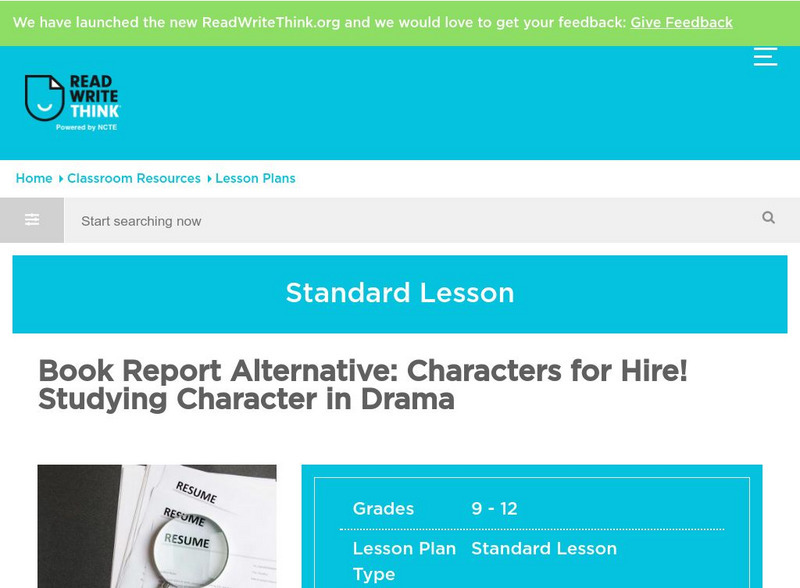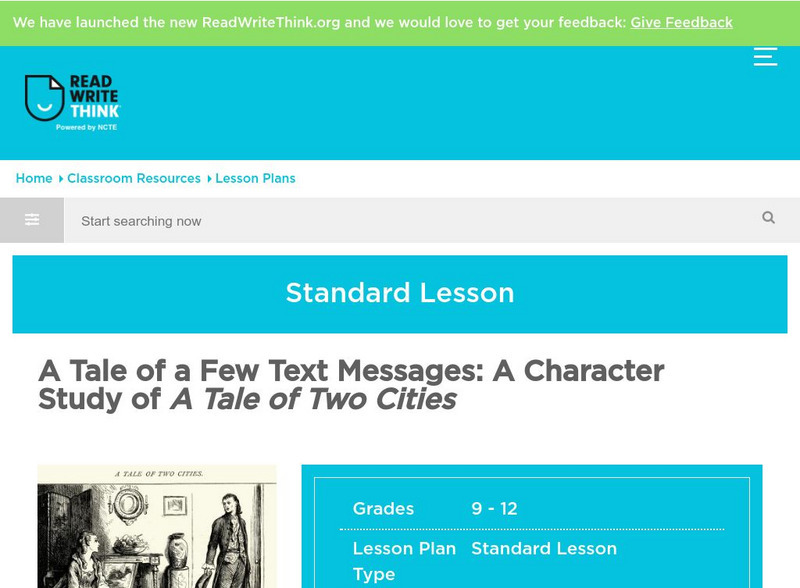Curated OER
Estimating Prices
Students practice making reasonable estimates. In this consumer math, students round purchase prices of items to estimate the total cost. Students practice using metal computations to arrive at estimates.
Curated OER
Hawthorne's "The Scarlet Letter"
Eleventh graders read Hawthorne's, "The Scarlet Letter" prior to doing the project. They find a contemporary person who has been shunned by society, write an essay, and give an oral presentation about the person.
Curated OER
The Underground Railroad
Third graders explore two different websites about the Underground Railroad. They make a graphic organizer to categorize the reasons a person might have for and against helping slaves escape on the Underground Railroad. They incorporate...
Curated OER
Message in a Bottle
Sixth graders write a short story about being stranded on a deserted island. After a brief geography review of locations at various latitudes and longitudes, 6th graders draft their story about being stranded. They use sensory and...
Curated OER
Simple Cycles
Students use Inspiration to map cyclical events. They recognize links between separate events and structural patterns. They explore the Internet Connection section to browse additional resources on teaching about cycles used in...
Curated OER
Are You Money Smart?
Learners figure out and discuss the irony of this coin-centric poem. They also practice persuasive letter writing, and identify and count coin/money values.
Curated OER
Cultural "I Amm" Speech Project
Eleventh graders use the internet and other sources to research a selected individual. They explore important events, challenges, and the impact and influence the person had on US History. Using the information gathered, 11th graders...
Curated OER
Property?
Students complete a list of seven items that they own with an appropriate value attached. They understand the principle of property and write an essay on why people owned slaves.
Curated OER
Identifying Types of Native American Stories
Students read Native American stories and record information on forms about them. They identify the type of story, its significance, and purpose. Students determine what the readers/listeners should learn from the stories.
Curated OER
Technology: Rating Inventions
Third graders brainstorm a list of inventions used daily. They use Kidspiration to create a web with inventions in the middle. Students choose three inventions from the web and rank them according to interest.
Curated OER
The Underground Railroad
Eleventh graders work in teams to play a game that is based on the Underground Railroad in Delaware.
Curated OER
Using Scholastic News to Introduce the Net
Third graders log on to the net, type in the address for Scholastic and browse the subjects for the week. They select one area of interest and generate five interesting facts about the article.
Curated OER
Divinity of hell
Students have to look at the text of the play Othello and cut the text in half. Each group then moves to the computer to their right and continues on with what that group wrote. They then have to stage the final script and perform in...
Curated OER
Free African-Americans in Delaware
Students work in groups of two and review the Abolitionist Movement. They observe the manumission/city directory and discover what it is and why it is so important. They read the manumission aloud and discuss why they were freeing their...
Curated OER
Book Review
Students write a five paragraph theme that explains how the novel which they read in this unit effectively utilized various literary elements to portray the impact of a disease on a population. They then decide which three literary...
Curated OER
Writing a Book About Farm Life
Second graders listen to the book, Pigaroom carefully. They create lists of animals that may be on the farm and then write their own books about farm life. They proofread their stories using editing checklists and exchange their paper...
Curated OER
Turkeys or Eagles?
Students discuss how Benjamin Franklin wanted the wild turkey (not the bald eagle) to be our national bird and then graph their preferences and discuss the survey results.
Curated OER
Historical Fiction - Based on facts or purely fiction?
Students, after reading an Accelerated Reader historical fiction book, research the actual historical time period portrayed in the book. Then, working in a cooperative learning group, they create a HyperStudio presentation.
Utah Education Network
Uen: 2nd Grade Act. 11: Character Sketch
This lesson engages students in describing the main character from Patricia Palacco's book, My Rotten Redheaded Older Brother. Students will analyze a picture of the main character and the teacher will write all of the students'...
PBS
Pbs Learning Media: Character Study: Scout Finch
This lesson focuses on the character of Scout Finch from the novel To Kill a Mockingbird by Harper Lee. It includes excerpts from the American Masters documentary entitled Harper Lee: Hey, Boo, discussion questions, teaching tips, and...
ReadWriteThink
Read Write Think: Character Analysis Through Job Placement
Contains plans for four lessons that ask students to write resumes and interview questions for characters in Tennessee William's "The Glass Menagerie," although the lessons can be easily adapted to other works as well. In addition to...
ReadWriteThink
Read Write Think: Studying Character in Drama
Online lesson that allows students to study and follow a Shakespearean character throughout a play, analyzing their actions, traits and dialogue as clues to characterization.
ReadWriteThink
Read Write Think: Tale of Text Messages: A Character Study of a Tale of Two Cities
Students engage in a character study of the numerous figures created by Charles Dickens in A Tale of Two Cities. They compare and contrast several forms of communication: email, text message, and telephone; complete a character study...
Scholastic
Scholastic: Richard Iii Character Study: Determined to Be a Villain [Pdf]
Four PDF formated pages with stand-alone lessons about a couple of passages from Shakespeare's "Richard III." Two pages are lesson plans, and two pages are handouts.























![Scholastic: Richard Iii Character Study: Determined to Be a Villain [Pdf] Lesson Plan Scholastic: Richard Iii Character Study: Determined to Be a Villain [Pdf] Lesson Plan](https://content.lessonplanet.com/knovation/original/34492-ec26882e2d38b1ecc5454e5c0ec0cbdd.jpg?1661409274)